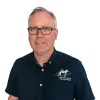What is the cruciate ligament and why do we care?
Cruciate ligament disease generally refers to one of 2 ligaments that provide a firm yet mobile attachment between the upper leg (femur) and the lower leg (tibia and fibula). The two ligaments are designated cranial (or anterior) and caudal (posterior), which corresponds to their points of attachment within the stifle (knee) joint. The one of most interest in veterinary medicine is the cranial ligament as it is frequently damaged. While it is possible to damage the caudal ligament, this is comparatively very rare and usually associated with significant trauma (car accidents for example).
Cranial cruciate ligament injury, on the other hand, is quite common and is the leading cause of hindlimb lameness in dogs. It too can be caused by acute trauma (eg. car accidents, large falls or getting legs caught in holes or fences) however most cases of damage are not due to one specific event, rather are due to a number of factors working in concert to progressively weaken the ligament to the point of injury.
Factors that lead to cruciate ligament disease
One factor is that studies have shown that the ligament weakens with age, so it is a condition that gets more prevalent as dogs get older. Cortisone will also weaken ligaments in general, so animals on cortisone for medical conditions or those with hyperadrenocorticism (Cushing’s Disease) will be more prone to damage.
Another factor is the stifle joint itself. Due to the requirements to be highly mobile, while being subjected to large muscular forces of the legs, the stifle is more vulnerable than other joints to damage.
The specific anatomy of stifles will contribute as well, some dogs placing more strain on the ligament when weight bearing than others of similar size. Genetics may play a part in this, with certain breeds more susceptible than others.
Weight is a contributing factor, large dogs are more susceptible than smaller breeds and overweight dogs more so than their thinner cousins.
Read more articles
- Log in to post comments



